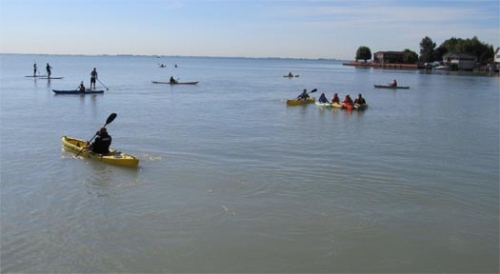Great Lakes paddling safety: 10 tips to keep you safe on the Great Lakes
As paddle sport enthusiasts, like canoeists and kayakers, venture out into the Great Lakes, they need to keep these safety tips in mind.
Water trails—a designated route along a river, lake, canal or bay specifically designed for people using small boats—along Michigan’s Great Lakes coastline are increasing in popularity. Paddling on the Great Lakes is a fun way to see the coast and take in Michigan’s abundant natural resources; but it can be different from paddling on inland lakes and rivers. Paddlers should keep the following 10 safety tips in mind:
- Check the Weather. Weather on the Great Lakes can change quickly. High winds and accompanying waves can easily swamp small watercraft. B
 efore
heading out, be sure to check local marine weather conditions, such as those available with the National Weather Service.
efore
heading out, be sure to check local marine weather conditions, such as those available with the National Weather Service. -
Buddy Up. Paddling alone is unwise. Even the most experienced paddler can run into trouble. Having a buddy along will increase safety.
-
Have a plan. Make a plan and give it to someone who is staying onshore. Be sure to include the names of the people in your party, time and location of departure, anticipated route and time you expect to get back. Don’t forget to check in once back so people know you have arrived home safely.
-
Safety Gear is a Must! Always wear a properly fitting U.S. Coast Guard-approved personal flotation device (life preserver). Wear protective footwear and clothing that can get wet. Expect to be in the water at some point on your trip. Pack personal gear in a waterproof bag, and secure it to your boat to avoid losing items if capsizing occurs. Bring at least two signaling devices, such as whistles, waterproof flashlights and cell phones in waterproof containers. Check out the safety gear gallery at Paddle Safe Paddle Smart.
- Know the Limits. Not all boats are created equal and not all paddlers should venture out onto the Great Lakes. Ensure that your boat is suitable for paddling conditions in Great Lakes waters. Good swimming skills and experience on smaller water bodies are recommended before paddling in the Great Lakes.
- Be Aware of Shipping Lanes. Although freighters can appear to be large and lumbering, they move much quicker than expected and may not be able to see smaller watercraft. High wakes t
 railing behind fast-moving, motorized watercraft are equally dangerous, and collisions can be deadly.
railing behind fast-moving, motorized watercraft are equally dangerous, and collisions can be deadly.
- Land Ho! Paddling far from shore can result in getting lost. Many people do not realize how large the Great Lakes are and often think they can easily paddle from one side to the other. Keep the shoreline in sight at all times.
- Steer Clear of Breakwalls. Breakwalls pose a problem when waves bounce off the walls and ricochet back into small watercraft. When combined with additional boat wake, small boats can easily capsize.
-
Improve Your Skills. Consider taking a paddlers safety course. Many local outfitters and paddling groups offer classes. Look for classes to enhance your canoeing and kayaking skill level, or join a paddling club to maximize your enjoyment when on the water.
- Keep International Borders in Mind. Lakes Superior, Huron and Erie are shared between the U.S. and Canada. U.S. and Canadian vessels, including kayaks and canoes, can freely cross the international boundary to explore neighboring waters. However, landing—anchoring, wading or touching bottom with a paddle—is illegal unless you immediately report your arrival to Canadian Customs. Violation of international border crossing laws can result in severe penalties. Returning from Canadian soil also requires that you report to U.S. Customs.
For more info about paddling in Michigan's Great Lakes or paddling safety, contact Mary Bohling, Michigan Sea Grant Extension Educator, Urban Southeast District, Detroit at 313-410-9431.



 Print
Print Email
Email




